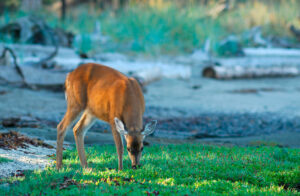
Wildlife
Should we kill one bird to save another?
On New Brunswick’s Machias Seal Island, predatory gulls are pushing endangered Arctic tern colonies to the brink, creating a dilemma for wildlife managers
- 2151 words
- 9 minutes
This article is over 5 years old and may contain outdated information.
Places
The majority of bird species sighted on the Atlantic island are “vagrants” far outside their ordinary range

Although it’s infamous for shipwrecked sailors washing up on its shores, Sable Island is also a haven for “vagrant” land birds blown astray by storms.
The sheer number of bird species that have been seen on the island — as many as 330 according to Dalhousie University ecologist Bill Freedman — has turned this isolated place into a birdwatcher’s paradise.
“Weird stuff shows up there,” says Freedman, who has been to the island a dozen times. Although the island harbours around 30 bird species that breed in the area endemically, the majority of species sighted are land birds that are blown out to sea or migratory birds that lost their way in storms.
These rare birds, sometimes called vagrants, are defined as extralimital because they are found so far outside their ordinary range. Freedman says some of the species on the island include sparrows from Western Europe or tropical birds, like the magnificent frigate from the Gulf of Mexico. He says that there have even been sightings of the rare Fea’s Petrel, which comes from islands off West Africa’s coast.
“Hurricanes come up from the tropics and all kinds of things get caught up in them,” he says.
Sable Island sits around 175 kilometres east of mainland Nova Scotia. Nicknamed the “Graveyard of the Atlantic,” this low-lying sand bar is difficult to see in low visibility and has been responsible for more than 350 recorded shipwrecks. Legends of the 42-kilometre crescent island speak of smugglers, pirates and wreckers waiting to pillage cargo from dying ships. Some of the wreckage from the Andrea Gail, the boat depicted in the movie The Perfect Storm, washed up on its shores.
Today, it’s a peaceful island and national park replete with no more than a half dozen people and a celebrated line of wild horses descended from a stock Freedman says was probably introduced in the mid-18th century by a Boston merchant. Some of the birds endemic to the island include Arctic and common terns, several species of gulls and the Ipswich sparrow that breeds there exclusively.
But like some of the sailors who have ended up stranded on the island, many of the birds have trouble surviving in such a foreign ecology. Birds like the cave swallow from the Southwestern United States and a number of woodpeckers would find the low shrubs and dune grass less than ideal. Although some may have the energy to fly back to more suitable climates, others end up spending their last days marooned on the crescent island.
Are you passionate about Canadian geography?
You can support Canadian Geographic in 3 ways:

Wildlife
On New Brunswick’s Machias Seal Island, predatory gulls are pushing endangered Arctic tern colonies to the brink, creating a dilemma for wildlife managers

Travel
Spread your wings with birdwatching’s elite guard in south Texas

People & Culture
Naming leads to knowing, which leads to understanding. Residents of a small British Columbia island take to the forests and beaches to connect with their nonhuman neighbours

Wildlife
Our love of deer runs deep. But as their numbers surge and damage mounts, it may be time for a reckoning.